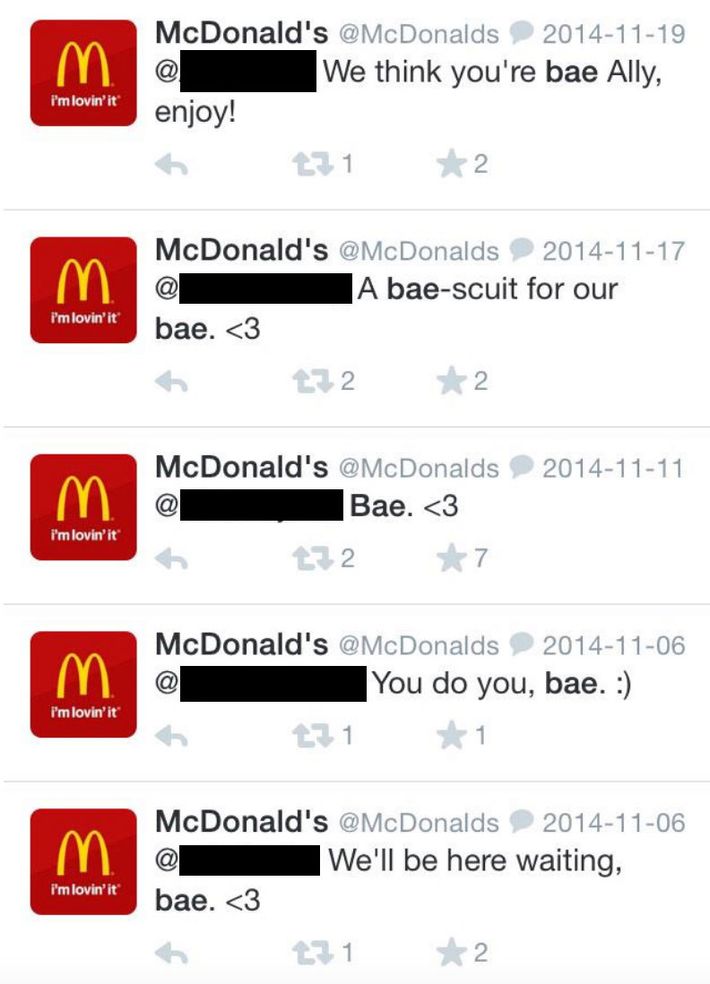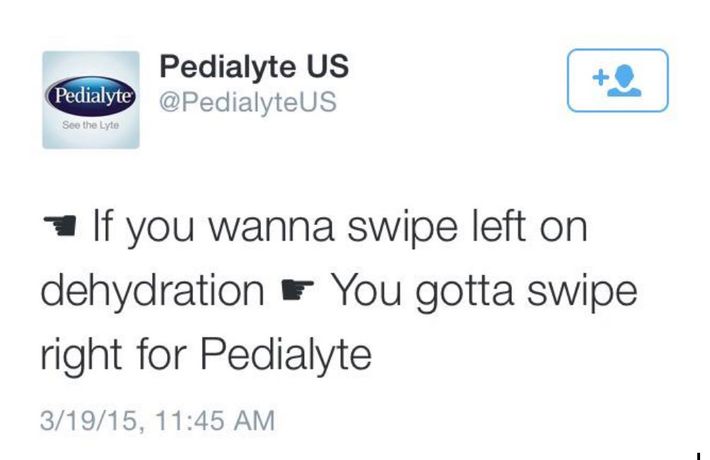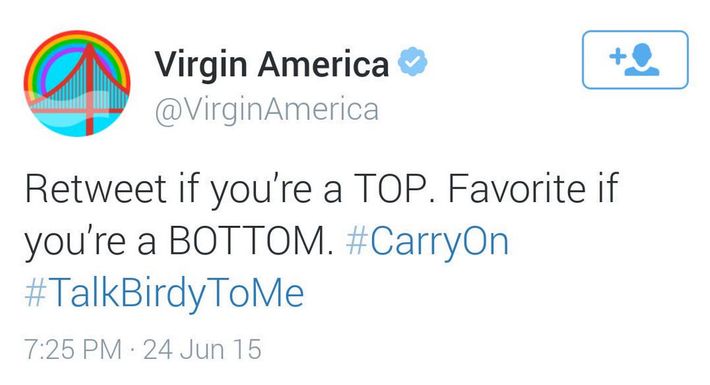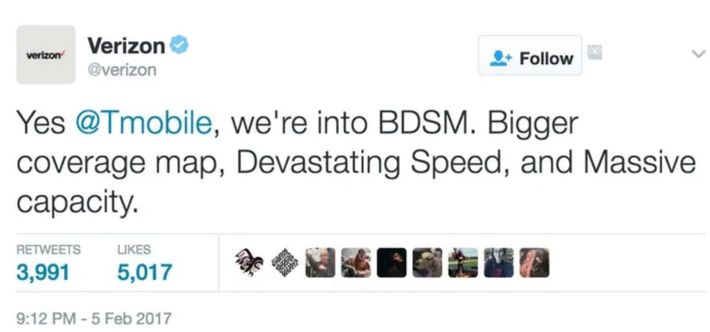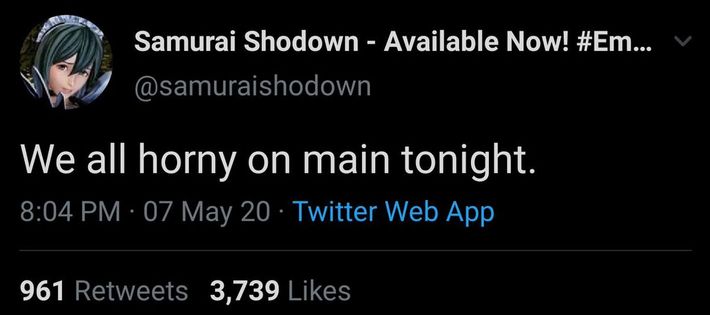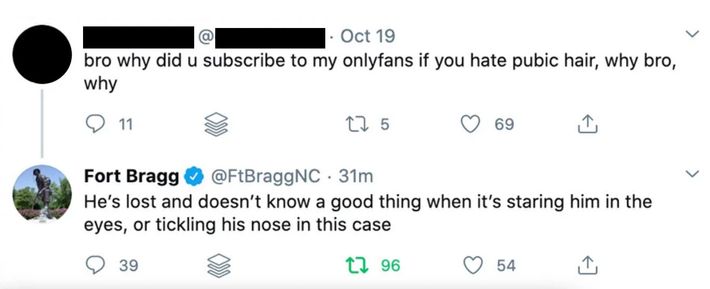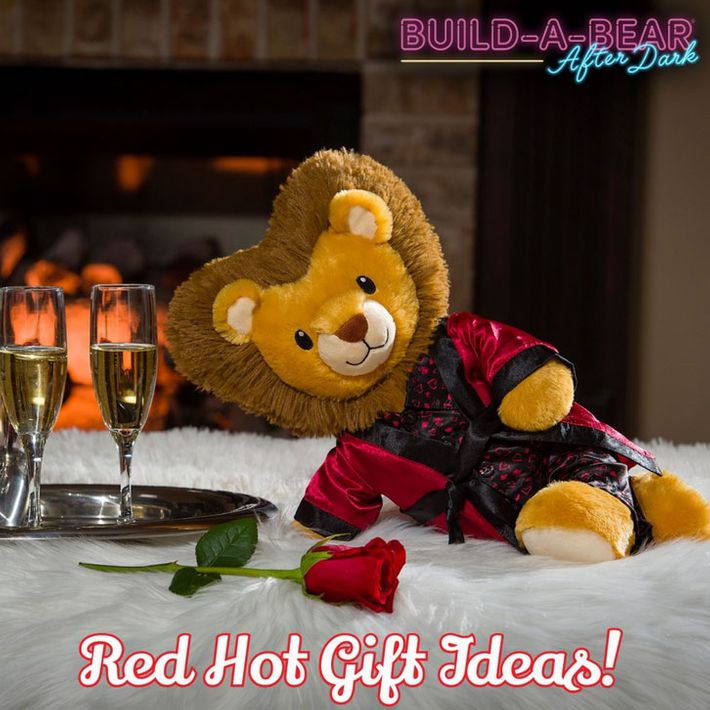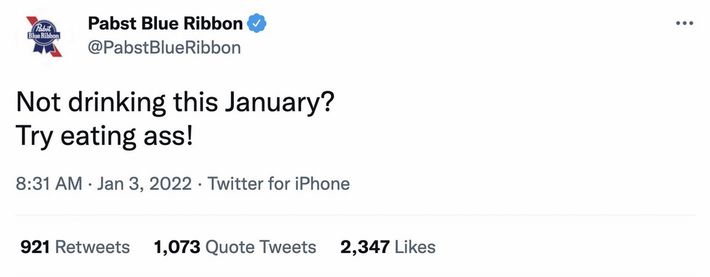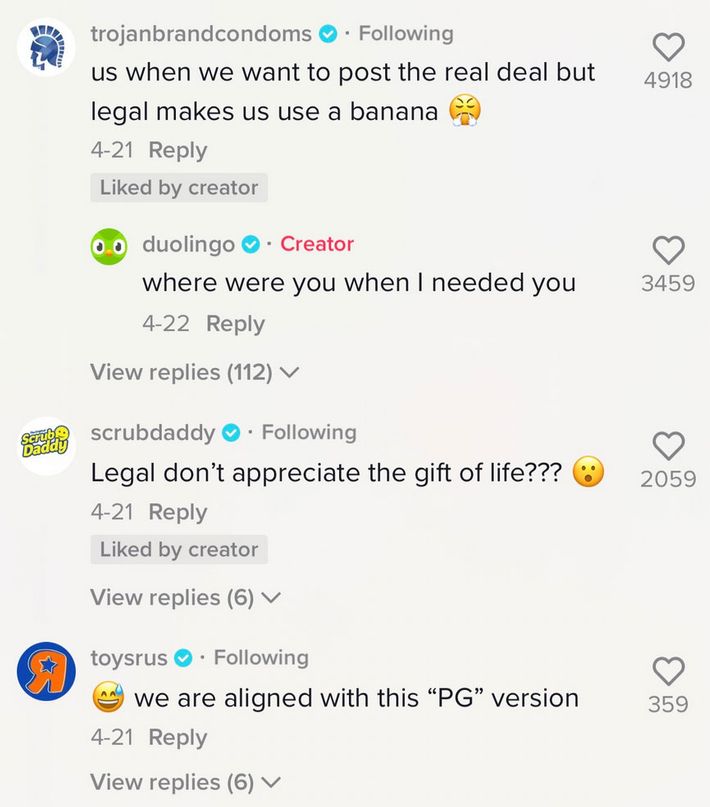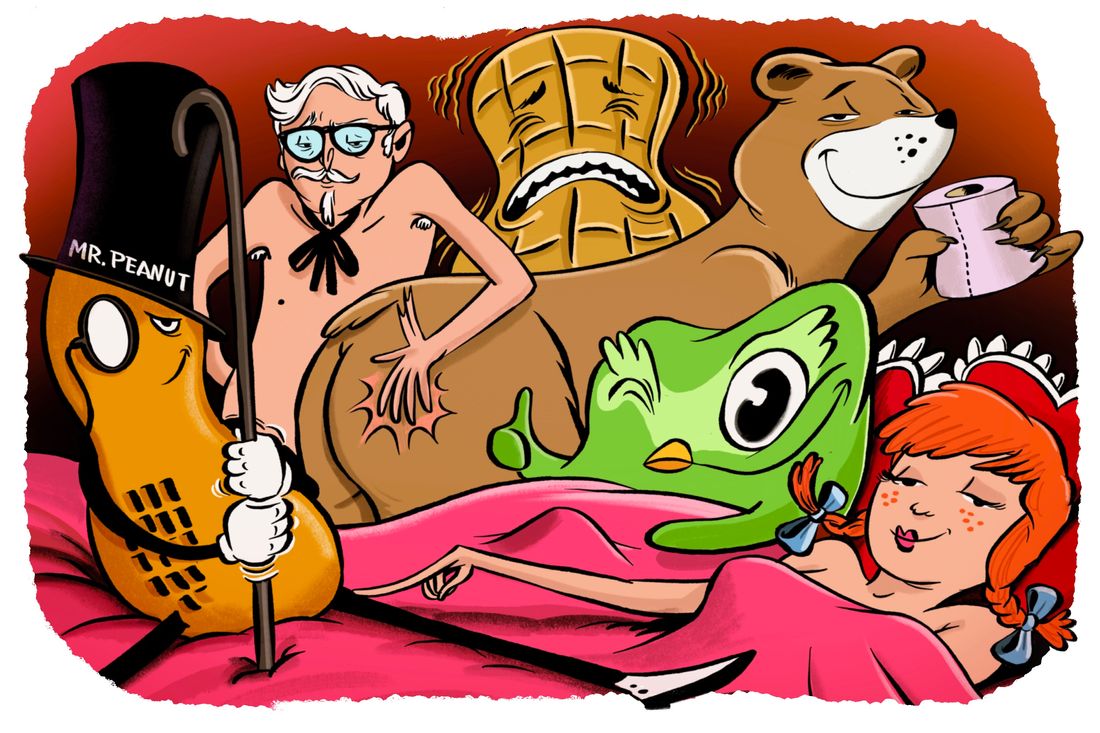
The history of brand personification on Twitter is long and filled with #authenticity fails. It started with consumer packaged goods and quick-service restaurants whose online mascots adopted personalities to promote products like light beer and fries. The personalities soon evolved: Brands from Burger King to Gushers announced anti-racist and antiwar stances; dipped their toes in feminist, pro-LGBTQ-rights, and pro-mental-health-awareness conversations; became fans of anime and weed; and got angsty. (Full disclosure: I formerly worked as the writer behind an angsty frozen-meat brand.) Soon, every consumer category and institution was embracing corporate personification, including government agencies and departments and entire states and countries.
For a time, acting sassy or edgy was enough for brands seeking to break through the social-media noise. These days, however, the golden ticket is acting horny. The general population has been unapologetically horny on main since 2018, thanks in part to the gradual destigmatization of sex work and porn. Marketers were quick to notice and acquiesce. Some brands were subtle about their newfound horniness: 69 jokes, sliding into DMs, swiping right. But as more risks tend to yield more rewards online, things escalated. They started acting blatantly aroused to bait engagement with explicit references to sex, orgasms, and more NSFW content that apparently is now suitable for work ÔÇö at least for companies themselves.
How did we get here? And what does our overstimulated future look like? LetÔÇÖs relive the history of horny brands to find out. All screenshots included below are tweets that have been deleted but not forgotten.
2014ÔÇô2017: From Bae to BDSM
Our story begins in the Wild West of 2014. Brands had little oversight and few industry guidelines. (Who could forget when US Airways accidentally tweeted porn at a customer?) Because of this adolescent landscape, social-media managers were stereotyped as ÔÇ£internsÔÇØ rather than professionals controlling their companyÔÇÖs online image.
One way they let loose was by gratuitously using trending terms like bruh and bae. Every brand from McDonaldÔÇÖs to AT&T did it for about a year, flirting their hearts out until the anonymous watchdog account Brands Saying Bae began mocking them en masse, resulting in some negative engagement and press for participants.
The terms eventually died out in 2015, but flirtatious moments continued as the Tinder meme ÔÇ£swiping rightÔÇØ was popularized.
Brands rarely published explicit sexual references intentionally, but Virgin America took a chance during Pride Month. Reactions were mixed, with some people thinking it was a mistake or a fail, others thinking it was funny, and most replying with general shock.
Barring a few exceptions, Brand Twitter was at this point a laughingstock, hence the ÔÇ£How do you do, fellow kids?ÔÇØ meme popularizing into an entire sub-Reddit. Pornhub was one of the few brands that gained positive traction on Twitter from 2015 to 2017 thanks in part to its personification as its social-media manager, Aria. The humorous, horny personality felt on-brand and natural, yet as a taboo outsider, it was rarely included in advertising coverage.
While the general public hadnÔÇÖt bought into hornyposting yet, furries were loud and proud. The community begged Tony the Tiger for sex in 2016 until it bullied him off the platform in 2018. By then, Chester Cheetah was its new daddy.
One month after a WendyÔÇÖs roast went nationally viral and made Brand Twitter mainstream in January 2017, Verizon initiated this horny interaction with T-Mobile during the Super Bowl as a nod to its commercial parodying 50 Shades of Grey.
A few months later, Jimmy JohnÔÇÖs gave a wink and a nod to this viral meme.
And Hamburger Helper had a viral moment with this flirty tweet:
Most large brands werenÔÇÖt ready for the heat. But one month after the VerizonÔÇôT-Mobile Super Bowl exchange, a prophecy was posted:
2018: No Nut November
In 2018, being horny on main was officially embraced by Twitter users, so brands subsequently loosened up. MoonPie and WendyÔÇÖs flirted in January ÔÇö a still innocent yet foreboding thread.
Once ÔÇ£No Nut NovemberÔÇØ hit its abstinence-urging viral peak, everything changed. And to the confusion of everyone on Twitter, Burger King came prepared. The brand tweeted this joke about waifu, controversial anime characters, often supposed to be adults but portrayed as childlike, that people have a crush on and/or pretend to be married to. Although the joke wasnÔÇÖt in the first person, it was received as if the brand itself were hornyposting.
A week later, Corn Nuts exploded onto the scene with this massive emoji nut and explicitly called out No Nut November with a meme:
Wanting in on the action, Mr. Peanut popped his cherry (nut?) by reminding people that peanuts arenÔÇÖt actually nuts; theyÔÇÖre in the legume family. Horny and educational.
The mascot ended the month with a simple acknowledgement after some viral success.
Nut jokes had been popularized in recent years, particularly with the nut-button meme from 2016 to 2017, making brand-themed nut content hot on the market ÔÇö a strategy later adopted by Nutter Butter.
To reiterate, this was the moment when consumer packaged goods (CPG) and quick-service restaurant (QSR) brands began embracing explicitly sexual content on social media. As horny-on-main normalization continued, they began experimenting with more popular innuendos, such as replying to 69 jokes with ÔÇ£nice.ÔÇØ
Another one was ÔÇ£sliding into DMs,ÔÇØ which had been widely used since 2014. As taboo memes became part of common parlance on Twitter, advertisers participated with less risk, chasing the coattails of culture with confidence.
Until this point, personified brands on social media were still broadly considered novel. New contenders were constantly emerging, the landscape was less inundated, but things were about to heat up.
2019: Netflix Makes It Rain
From this point onward, engagement rates for horny content snowballed as marketers built case studies on why it was worth producing. Being horny on main was more prevalent than ever, with stans saying things like ÔÇ£Run me over with a busÔÇØ or ÔÇ£Step on my neckÔÇØ to (or about) celebrities.
Every brand was now personified, and an ecosystem emerged with their regularly engaging one another to mutually boost content, whereas in prior years, they would mostly just roast one another from afar. Because of this, users became increasingly annoyed at this #relatable content and began spamming posts with the now iconic Silence Brand meme.
On the flip side, many brands began growing stan bases by tapping into specific subcultures. Corn Nuts, a dark horse that busted this viral nut in January, continued to double down on nut memes, claiming their presence led to sales. The brand went viral months later for asking people, ÔÇ£WhereÔÇÖs the craziest place youÔÇÖve nutted?ÔÇØ in a now-deleted tweet.
Netflix briefly took a break from its horny commentary to become the horny police for people who were thirsting over Ted Bundy.
February turned out to be a huge month for horny brands. Devour launched a Super Bowl commercial that rolled out hashtags like #FreeTheFoodPorn and #3MinuteMen.
Dietz & Watson launched its Dietz Nutz campaign on social media the same week to ride the hype, Pluckers Wing Bar accidentally posted a Phineas and Ferb male-pregnancy kink meme, Burger King referenced Nicki MinajÔÇÖs ass-centric song ÔÇ£Anaconda,ÔÇØ and Netflix dropped this reference to its genitals:
In fact, Netflix progressively sprinkled more horny content through its accounts all year, interacting across countries and shows. ÔÇ£Netflix and chillÔÇØ memes had peaked years earlier, but they were now being integrated into a global marketing strategy.
That said, the yearÔÇÖs most cursed moment came from known meat haver ArbyÔÇÖs, which introduced its own waifu.
Not to be outdone, Mr. Peanut topped his previous yearÔÇÖs No Nut November post with this bombshell:
Finally, after years of buildup, all horny hell broke loose in December when Netflix tweeted a viral thread asking, ÔÇ£WhatÔÇÖs something you can say during sex but also when you manage a brand Twitter account?ÔÇØ
Hundreds of brands responded with sex jokes, including Pepsi, Ben & JerryÔÇÖs, Charmin, T-Mobile, NYT, Petco, StubHub, Instagram, TED, Groupon, and Adobe. This whipped up a media frenzy, mainstreaming the phenomenon.
Marketing departments worldwide were given the green light to be horny, just this once. As a treat.
2020: Pandemic Blue Balls
In January, Boston Market attempted to re-create NetflixÔÇÖs success. Unfortunately, the novelty had worn off. Rather than accounts replying with clever innuendos, shitposters piled on with zingers like ÔÇ£Spit in my mouthÔÇØ and ÔÇ£So no head?ÔÇØ as well as spammed images of a man penetrating a raw chicken (hyperlinks will not be provided). The brand did its best to hide explicit images.
Elsewhere, Slim Jim was amassing a cult following for its consistent use of 69-joke memes on Instagram, Seagrams slid into 7UpÔÇÖs Instagram DMs for a planned campaign, and Paddington Bear shot his shot with Florence Pugh.
2020 was off to the races. Then pandemic blue balls hit. Quarantine made people excessively horny, leading to excessive hornyposting. This included the ÔÇ£go to horny jailÔÇØ reaction meme, the ÔÇ£quarantine and chillÔÇØ meme, and jokes about being sexually attracted to inanimate objects. But COVIDÔÇÖs aura put a plug in brand shenanigans, horny or otherwise. Market forces pressured companies to shut up or become public-health mouthpieces, before shifting into racial-justice advocates months later during Black Lives Matter protests.
One of the few brands brave enough to stay in the game was convenience store Kum & Go, which ironically had never personified itself as horny and poked fun at its name only to let users draw their own conclusions.
The classic video game Samurai Shodown got into some hot water among the gaming community for declaring an evening of horniness in May.
And in September, Tinder India showed some thirst for the cricket star Rahul Tewatia.
October graced the world with a string of tweets from the official military installation at Fort Bragg, which later claimed its account had been hacked but then confirmed the perpetrator was actually a horny admin.
The official U.S. Navy account posted this in response to the debacle:
To cap off a quiet year, BarkBox relaunched a Pigs in a Blanket toy in response to its being called a pocket pussy.
Most brands were posting blue balls for a year. But nothing could stop what was coming.
2021: Horny Brand Normalization
Over a year into the pandemic, marketers slowly started posting normally again. People were tired of PSAs and ready for more unhinged corporate titillation. Publications predicted 2021 would be an exceptionally horny year ushering in a new ÔÇ£Summer of LoveÔÇØ and dubbed it the ÔÇ£new Roaring ÔÇÖ20s.ÔÇØ
Things started slow with Build-A-Bear advertising ÔÇ£after darkÔÇØ adult content.
Then Totinos made a lipless Tinder profile meme. Classic brand content, really.
Skittles announced to the world that it was single.
Business Insider reported a horny-ad spike in March, and the following month, Spanish KFC ÔÇö an account known for its meme antics ÔÇö posted an artistÔÇÖs Colonel Sanders thirst trap without permission, following the brandÔÇÖs general strategy of sexualizing its founder.
Shortly after, SpongeBob reminisced about the time Squidward imagined his rival Squilliam topless.
Things got even spicier when Wingstop threw caution to the wind by flirting with an OnlyFans model. No, it wasnÔÇÖt hacked. Yes, the tweet is still up.
Tushy shouted out bottoms for Pride Month, a fitting double entendre for a bidet brand.
Later that month, DennyÔÇÖs referred to itself as ÔÇ£DaddyÔÇÖsÔÇØ and knew exactly what it was doing.
After Netflix ended 2019 with its debauched thread, it was inevitable that another streaming service would say the quiet part out loud in October.
This trajectory continued on Twitter, while a similar one was starting on TikTok. The Duolingo owl, Duo, began thirsting over British singer Dua Lipa in a series of videos, making Duolingo the first high-profile brand to express explicitly horny behavior on the platform. This unrequited down-bad campaign continued into 2022.
Back on Twitter, Nutter Butter kicked off another No Nut November by following up its viral ÔÇ£nut eraÔÇØ tweet from October and taking a page out of Mr. PeanutÔÇÖs and Corn NutsÔÇÖ books.
The Hooters owl, Hootie, reminded Duo that it wasnÔÇÖt the only horny owl mascot by showing off its new ÔÇ£pearl necklaceÔÇØ in this not-so-subtle meme:
Trident Gum must have been inspired because it pulled out another ejaculation-themed post the next day with just enough plausible deniability.
Scrub Daddy ÔÇö a brand that claims its TikTok presence has led to increases in sales ÔÇö entered the arena in February with a risqu├® video but hadnÔÇÖt quite blown up yet. That changed in December when its first suggestive video took off, letting Duolingo know it wasnÔÇÖt the only horny brand on the block.
2022: Just the Tipping Point
Horny-brand critical mass was quickly approaching. This became clear when PBR suggested its followers try eating ass for Dry January, marking an aggressive tone shift in the landscape. As engagement grew, the brand deleted the post, apologized, and ended up firing its social-media manager. The viral incident was a reminder that there are still some limits in this absurd landscape.
The very next week, Oregon baseball team the Portland Pickles posted an ÔÇ£accidentalÔÇØ pickle pic. As a baseball team, they clearly arenÔÇÖt constrained by the same guardrails as most CPG and QSR brands.
Mars put its foot down against this sexualization trend by desexifying its Green M&M, just months after the same thing happened to Lola Bunny. This led to outrage from fans thirsting over the mascot, including Tucker Carlson, and somehow was tied into cancel culture ÔÇö because everything is a discourse now.
Meanwhile, back on TikTok, Duolingo ramped up its one-sided flirtation campaign with Dua Lipa, posting a joke about Duo swimming in her piss. While horny brand content on Twitter was typically met with controversy or outrage, the same was met with praise or neutral shock on TikTok ÔÇö owing to its meme-centric zoomer culture as opposed to TwitterÔÇÖs more news-centric millennial culture.
BarkBox jumped into the mix by riffing on the fact that many of its pet toys look like dildos as well as several body parts, a commentary similar to PetcoÔÇÖs tweet reply to Netflix in 2019. Users rewarded BarkBox with its highest performing TikToks to date, so naturally the brand continues to meme about it.
Scrub Daddy persisted in matching DuolingoÔÇÖs unhinged humor, with both brands using the same joke format to reference the slang term ussy, which people use to describe things as a pussy ÔÇö e.g., ÔÇ£DuoussyÔÇØ or ÔÇ£scrubussy.ÔÇØ
To match his Twitter presence, Mr. Peanut sexualized himself with a muscular shell as ÔÇ£Daddy NutÔÇØ on TikTok ÔÇö the olÔÇÖ Colonel Sanders treatment.
Speaking of Twitter, a shitposter spread a viral rumor in April that Snickers had removed the candy barÔÇÖs ÔÇ£dick veins.ÔÇØ Rather than running PR cover, the brand took this opportunity to announce that the veins remained. As Winston Churchill once said, ÔÇ£Never let a good crisis go to waste.ÔÇØ
Oh, and Fleshlight couldnÔÇÖt resist chiming in.
On April 19, horny-brand history changed forever with the DuolingoÔÇôScrub Daddy collab users had been waiting for. These two horsed around with a few TikTok videos before culminating in Scrub Daddy getting Duo pregnant. But wait, thereÔÇÖs more: We then witnessed the birth of several Scrub Babies to the song ÔÇ£Glad You Came.ÔÇØ
Duolingo ended up deleting its video (Scrub Daddy kept its up) and published a PG version with some other brands chiming in for comment-section clout.
Our story doesnÔÇÖt end here. Despite the name, Hot Pockets managed to keep its content PG until the infamous 2019 Netflix sex thread, when it dipped its toes into the horny pool. In May, Hot Pockets jumped into the deep end.
The same day, Mountain Dew decided it was time for a thirst trap and dropped this nude on TikTok. There must have been something in the water.
In June, KFC announced the Jack Harlow Meal, leading rapper and shitposter Lil Nas X to tweet a picture of himself at KFC saying, ÔÇ£Your employee just slapped me, called me a bottom, and refused to give me my change.ÔÇØ KFC decided to play along.
The following week, Skittles liked a rainbow dick pic posted by gay OnlyFans star Chris Stone. Was it a Pride Month Easter egg? An accident? WeÔÇÖll never know. But the post has since been unliked, leaving us with more questions than answers.
Arizona Tea went on to tweet about ÔÇ£big cans,ÔÇØ then acted confused when horny replies rolled in. Whatever you do, donÔÇÖt click its ÔÇ£Hidden TweetsÔÇØ button.
Nutter Butter once again reminded us that it has permission to make jokes about nutting, an approach that continually goes viral in the marketplace of ideas.
This time around, Oreo replied with a nod to orgasms.
Horny-brand normalization had come so far that RadioShack, which was acquired by Retail Ecommerce Ventures in 2020 and partly rehabilitated as a crypto swap, began tweeting like an edgy Elon Musk fan to generate buzz in the online tech community ÔÇö a space that abides by the ÔÇ£All press is good pressÔÇØ ethos. It fired off an explicitly horny tweet two days after Nutter Butter, which was temporarily hidden after being flagged by Twitter because of either suspicious activity or reports. The brand was unapologetic, and a media frenzy ensued, including coverage by CNN and NBC.
After getting the reaction it was after, the strategy continued.
This is where society is now. Eating ass. Dick veins. Horny crypto outrage bait. Pickle pics. Nutty shit. Mascots having sex for clicks. Social media didnÔÇÖt start the fire; the fear of brand irrelevance was always burning, long before Brand Twitter. But social media did make it a lot, lot hornier.


